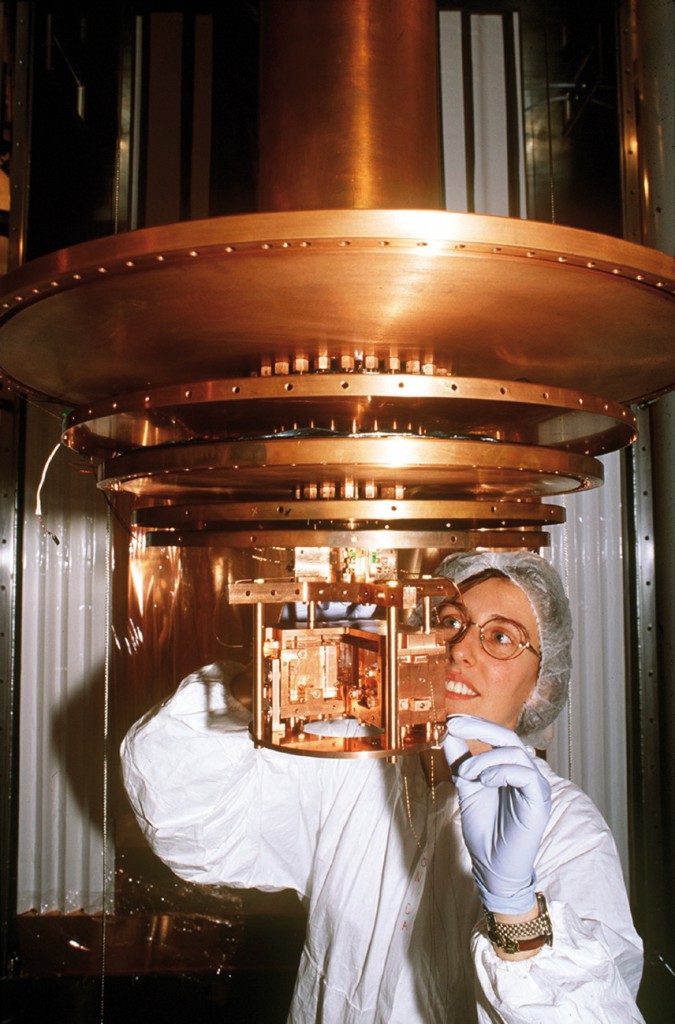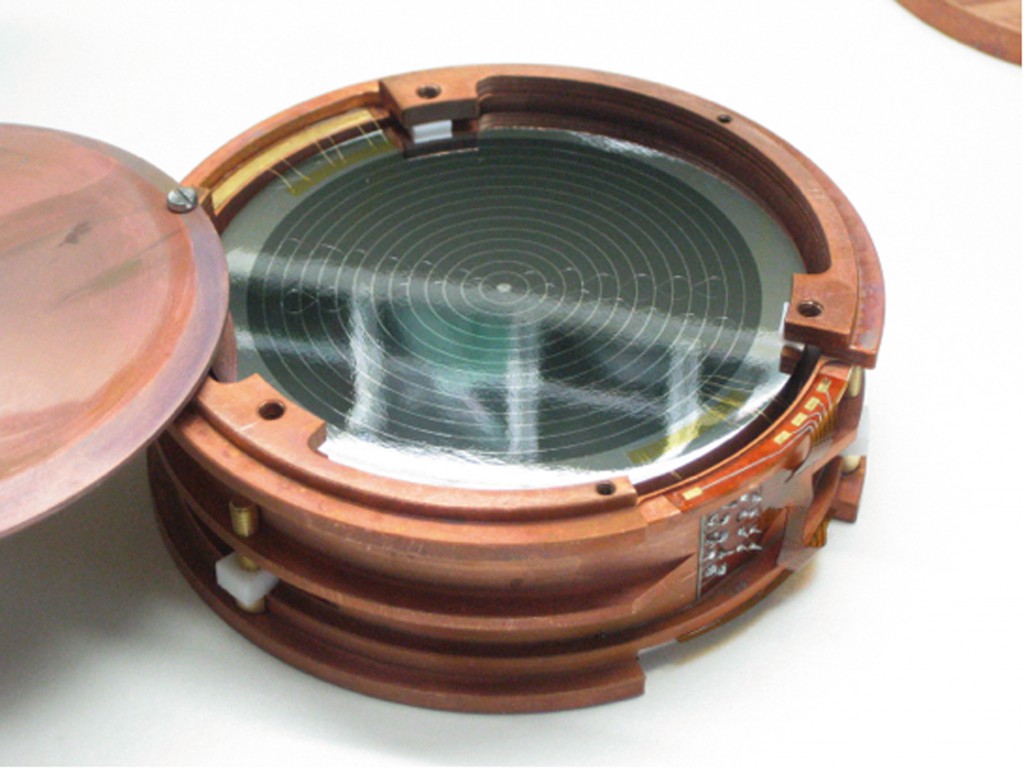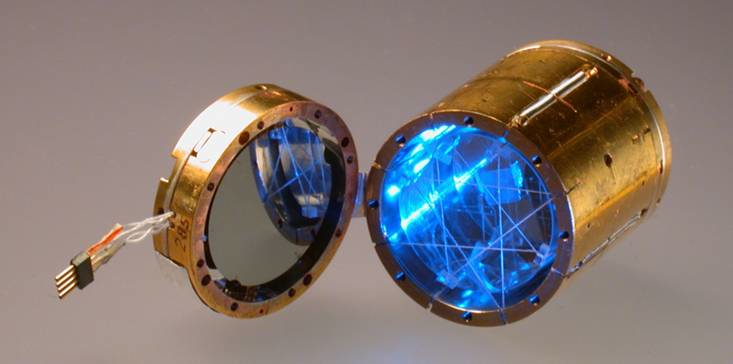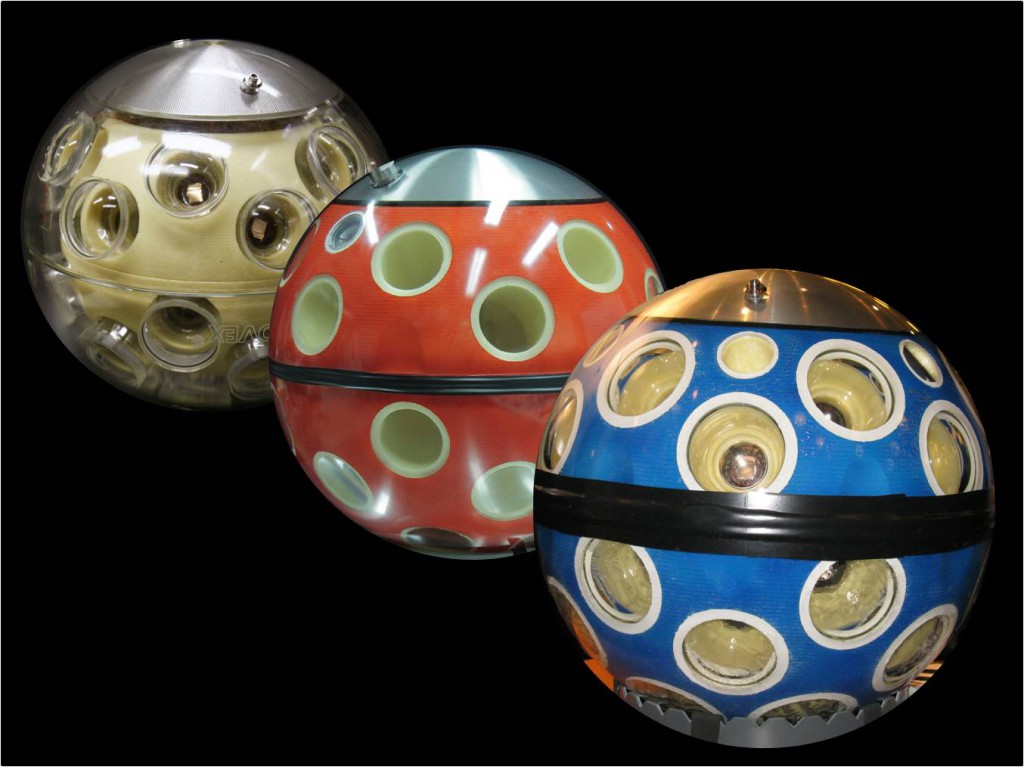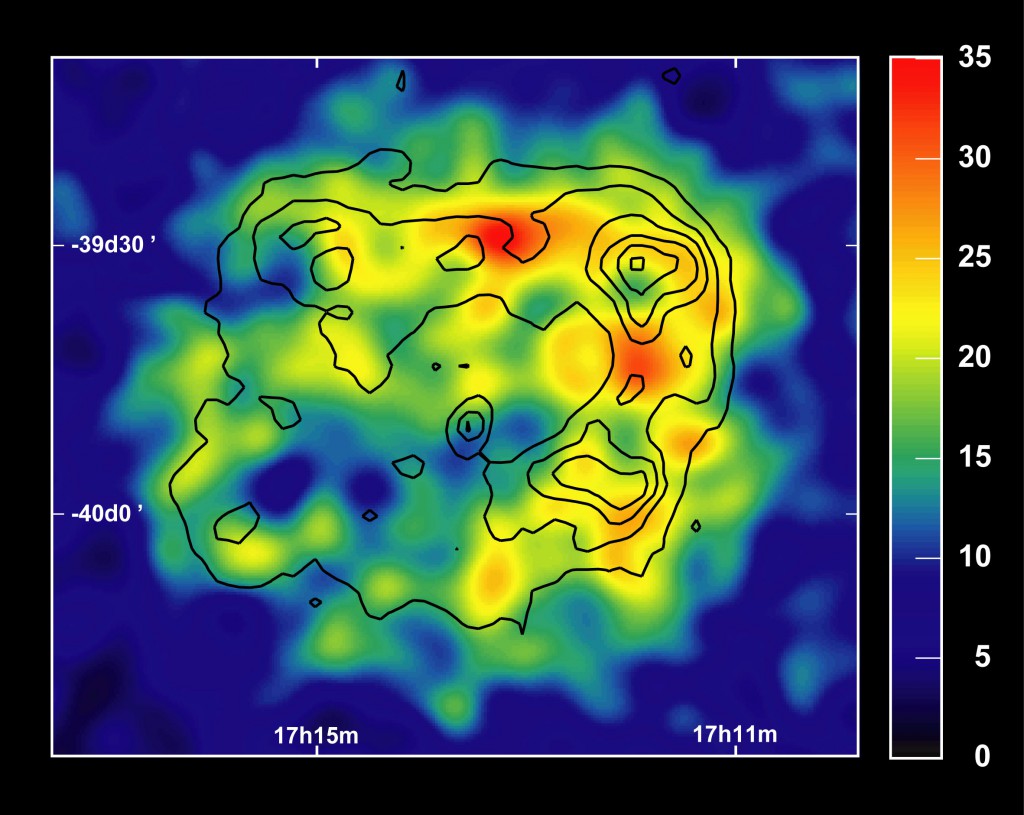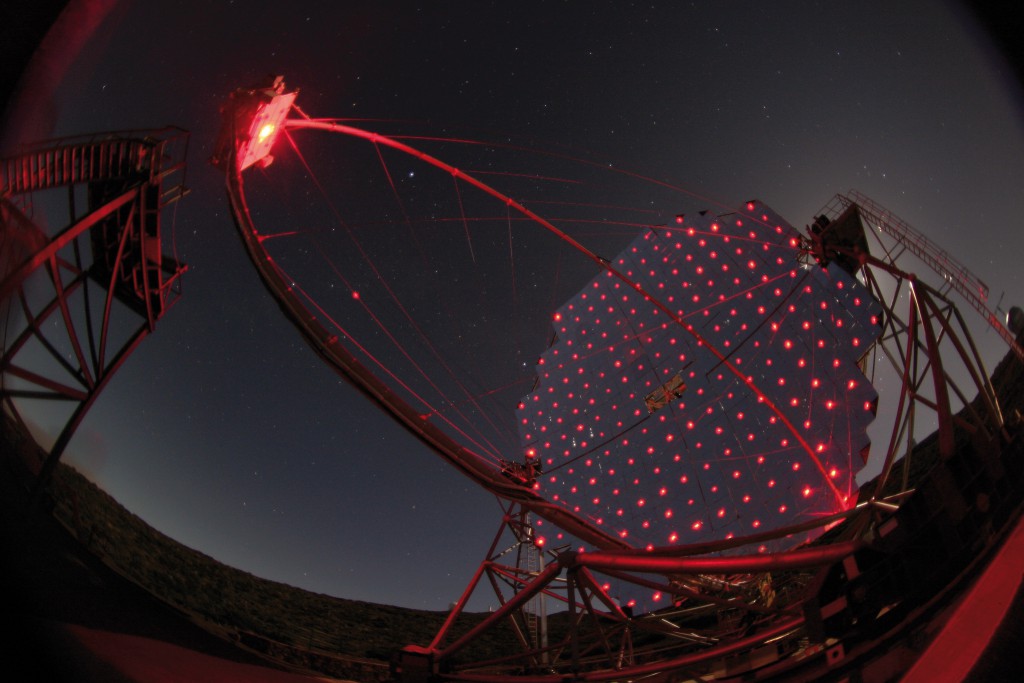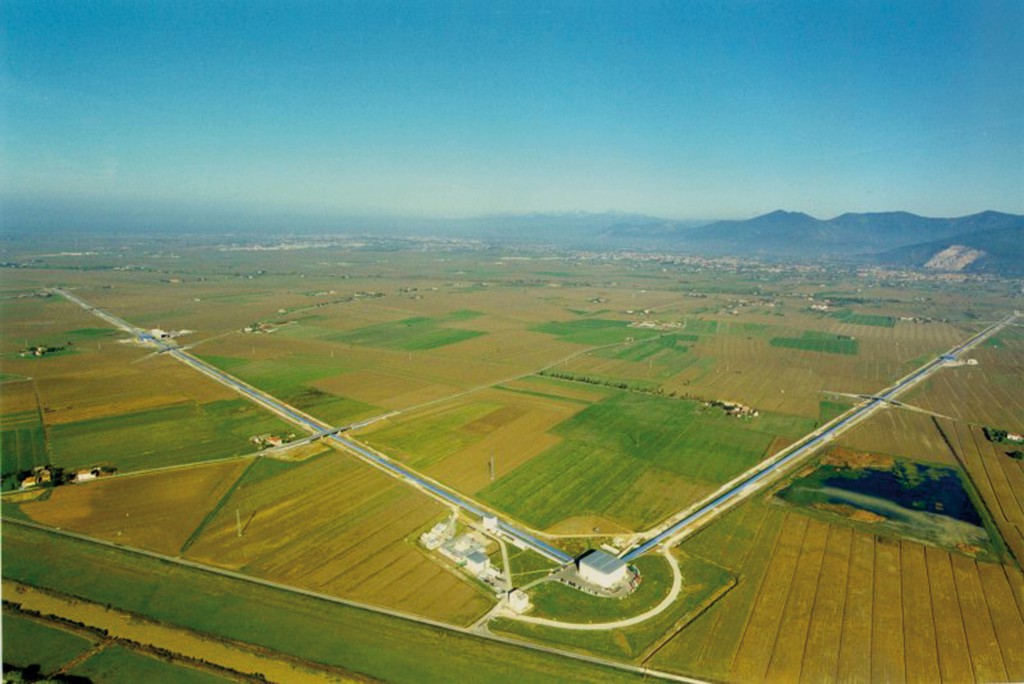-
KATRIN
Precision manoeuvre for a precision experiment: The huge KATRIN vacuum vessel merely passes a narrow street on its way from the factory to the Research Centre in Karlsruhe (Credit: ASPERA / KATRIN Collaboration).
wp-content/uploads/2018/06/1225121121_katrin-1024x683.jpg
-
NEMO-3
The NEMO-3 detector in the Laboratoire Souterrain de Modane (NEMO-3 collaboration / ASPERA).
wp-content/uploads/2018/06/1225195745_detector_nemo3-1024x847.jpg
-
CRESST
The CRESST detector in the Gran Sasso Laboratory searches for a combination of light and heat signals in crystals cooled down to about 20 milli-Kelvin (Credit: ASPERA / CRESST collaboration).
wp-content/uploads/2018/06/1225123027_cresst-675x1024.jpg
-
Argon
The central part of a 100-litre liquid argon detector being installed by the WARP collaboration in the Gran Sasso Laboratory (Credit: ASPERA / WARP collaboration).
wp-content/uploads/2018/06/1225123317_warp-768x1024.jpg
-
XENON
XENON is a next-generation Dark Matter Direct Detection experiment, which will use liquid xenon as a sensitive detector medium to search for WIMPs (Weakly Interacting Massive Particles). These particles, postulated by Super Symmetry (SUSY), are believed to have a mass in the neighborhood of 100 GeV, to ignore Electromagntic Interactions, and to permeate the Universe (Credit: XENON collaboration).
wp-content/uploads/2018/06/1225124422_xenon-1024x768.jpg
-
Edelweiss bolometer
The goal of Edelweiss is to detect the dark matter of our Galaxy through its interactions in detectors operated in underground laboratory. Here is a Germanium bolometer (Credit: CEA / IRFU / ASPERA).
wp-content/uploads/2018/06/1225189347_edelweissbolometer-1024x1018.jpg
-
Edelweiss bolometer
A combination of heat and electrical current in germanium crystals is recorded by the Edelweiss detector in the Laboratoire Souterrain de Modane (Credit: Edelweiss collaboration / ASPERA).
wp-content/uploads/2018/06/1225191305_edelweiss-1024x769.jpg
-
Zeplin III
With an array of 31 photomultipliers, the Zeplin III detector in the Boulby Underground Mine records light flashes in liquid xenon. It also measures the related electrical current (Credit: Zeplin collaboration / H. Araujo / ASPERA).
wp-content/uploads/2018/06/1225191609_zepliniii1-1024x773.jpg
-
ROSEBUD double bolometer
Double bolometer configuration used in the ROSEBUD experiment. A scintillating crystal (a 91 g BGO, right) and a thin Ge disk (left) used as optical bolometer”. ROSEBUD (Rare Objects SEarch with Bolometers UndergrounD) is an experiment aiming at the direct search of cold dark matter (WIMPs) by measuring the recoil energy transferred to the detector nuclei after a WIMP-nucleus elastic scattering. In ROSEBUD this deposited energy is measured through the following temperature increase in the crystal used as target kept at about 20 mK (Credit: Rosebud Collaboration).
wp-content/uploads/2018/06/1225287791_rosebud.jpg
-
Technician at work
Technician at work. (Credit: ASPERA / EDELWEISS-II collaboration).
wp-content/uploads/2018/06/technology-1024x672.jpg
-
ANTARES
First of the twelve lines of the ANTARES Neutrino telescope before deployment in Feb 2006 (© ASPERA / ANTARES collaboration).
wp-content/uploads/2018/06/1214223777_antares-1024x611.jpg
-
KM3NeT
KM3NeT: Three Optical Modules
Three different designs for optical modules for KM3NeT have been developed during the Design Study. A “traditional” one with a single 8 inch PMT inside a 13 inch glass sphere and two innovative ones: one with two 8 inch PMTs in a capsule shaped glass sphere, the other with 31 3 inch PMTs in a 17 inch glass sphere. (Credit: Propriety KM3NeT Consortium)
wp-content/uploads/2018/06/1275407827_om-threemechanicalmodels-1024x767.jpg
-
H.E.S.S
H.E.S.S is an array of four 13-metre Cherenkov telescopes, 120 metres apart in Namibia. (© H.E.S.S collaboration / ASPERA)
wp-content/uploads/2018/06/1214304097_hess_2-768x1024.jpg
-
H.E.S.S
H.E.S.S is an array of four 13-metre Cherenkov telescopes, 120 metres apart in Namibia. (© H.E.S.S collaboration / ASPERA)
wp-content/uploads/2018/06/1214304100_hess_3-1024x768.jpg
-
H.E.S.S
H.E.S.S is an array of four 13-metre Cherenkov telescopes, 120 metres apart in Namibia. (© H.E.S.S collaboration / ASPERA)
wp-content/uploads/2018/06/1214304091_cherenkov-1024x683.jpg
-
Supernova shell
Supernova shell in TeV gamma rays. First image in November 2004 of a supernova shell in TeV gamma rays, by the H.E.S.S Cherenkov telescopes array in Namibia. (© H.E.S.S collaboration / ASPERA)
wp-content/uploads/2018/06/1214304094_hess-1024x815.jpg
-
MAGIC
MAGIC is a great Cherenkov telescope, made with a mirror surface of 240 square metres, and located in the Canary Islands. (© MAGIC collaboration / ASPERA)
wp-content/uploads/2018/06/1214304103_magic-1024x683.jpg
-
MAGIC
MAGIC is a great Cherenkov telescope, made with a mirror surface of 240 square metres, and located in the Canary Islands. (© MAGIC collaboration / ASPERA)
wp-content/uploads/2018/06/1214304105_magic_2-1024x683.jpg
-
MAGIC
MAGIC Cherenkov telescope. The first of the two huge 17-meter dishes of the MAGIC telescope at La Palma (Credit: Robert Wagner, MPI for Physics, Munich / ASPERA).
wp-content/uploads/2018/06/1225189037_magic-1024x683.jpg
-
The Milky Way
The Milky Way by H.E.S.S. The band of the inner parts of the galactic plane as scanned with the H.E.S.S. telescope. The plane turns out to be lined with sources of TeV gamma radiation, some of them not known from any other wavelength.
wp-content/uploads/2018/06/1225192003_milky-1024x776.jpg
-
ARGO-YBJ
ARGO-YBJ, an air shower array of detectors covering an area of about 6700 square metres in Tibet. (© INFN / ASPERA)
wp-content/uploads/2018/06/1214305068_argo-ybj-1024x922.jpg
-
AUGER
View of AUGER water tanks. The Pierre Auger observatory consists of 1600 such detectors distributed on a 3000 square kilometres area in Argentina. (© Pierre Auger collaboration / ASPERA)
wp-content/uploads/2018/06/1214305070_auger-1024x768.jpg
-
KASCADE-Grande
View of KASCADE-Grande, an extensive array detector covering an area of 0.5 square kilometres in Germany. (© KASCADE collaboration / ASPERA)
wp-content/uploads/2018/06/1214305071_kaskade-grande-1024x667.jpg
-
AUGER
A water tank of the cosmic rays Pierre Auger Observatory, with the Andes in the background (Credit: ASPERA / Pierre Auger Observatory).
wp-content/uploads/2018/06/1225188828_auger-1024x768.jpg
-
LOFAR
View of LOFAR’s antennas. LOFAR will be the largest radio telescope ever built. When finished, it will consist of 15,000 small antennas, distributed over 77 stations in the northeast of the Netherlands and nearby parts of Germany. Among other goals, LOFAR is expected to be used for detecting extensive air showers originating from very high-energy cosmic rays, and perhaps even from neutrinos. (© LOFAR / ASPERA)
wp-content/uploads/2018/06/1214305073_lofar-1024x768.jpg
-
Cosmic Rays
Cosmic rays. Before reaching the Earth’s surface, cosmic ray messengers interact with the constituents of the atmosphere, changing their nature and energy. A large variety of secondary particles, which decay or make new collisions, is produced. (© L.Bret / Novapix /ASPERA)
wp-content/uploads/2018/06/1214305081_cosmic_rays-1024x731.jpg
-
GEO 600
The GEO 600 gravitational waves interferometric experiment. The GEO600 project aims at the direct detection of gravitational waves by means of a laser interferometer of 600 m arm-length. Gravitational waves are extremely small ripples in the structure of spacetime caused by astrophysical events like supernovae or coalescing massive binaries (neutron stars, black holes). They were predicted by Albert Einstein in 1916, and observed directly by LIGO-Virgo for the first time in 2015.
wp-content/uploads/2018/06/1225118757_geo600-1024x699.jpg
-
VIRGO
The VIRGO interferometric gravitational detector. The Virgo detector for gravitational waves consists mainly in a Michelson laser interferometer made of two orthogonal arms being each 3 kilometres long. Multiple reflections between mirrors located at the extremities of each arm extend the effective optical length of each arm up to 120 kilometres. Virgo is located within the site of EGO, European Gravitational Observatory, based at Cascina, near Pisa on the river Arno plain.
wp-content/uploads/2018/06/1225119228_virgo-1024x684.jpg
-
Gravitational waves
Gravitational waves simulation. Modelling of gravitational waves produced by the merging of two black holes.
(Credit: MPI for Gravitational Physics/W.Benger-ZIB)
wp-content/uploads/2018/06/1225119050_gw-1024x546.jpg
-
Gravitational waves
Gravitational waves simulation. Simulation of gravitational waves produced by merging black holes. (Credit: NASA)
wp-content/uploads/2018/06/1225119993_gravitationalwaves-1024x1024.jpg
-
The Einstein Telescope
The Einstein Telescope project. E.T. is the long-term future project of groundbased gravitational wave astronomy. With an observed volume a thousand times larger than that of the second-generation detectors, E.T. will record many thousands of events per year, and, in a network arrangement, have an unprecedented sensitivity at 10 Hz to a stochastic gravitational wave background from the Big Bang (Credit: Nikhef/Jo van den Brand / ASPERA).
wp-content/uploads/2018/06/1225126193_et-1024x724.jpg
-
AMS
AMS space experiment. View of the AMS space experiment central tracker detector in its clean room at CERN. One of the main goals of AMS is to find either an explanation for the disappearance of antimatter or else proof of its existence tucked away in a remote corner of the Universe. For this quest, it will go where no antimatter experiment has ever gone before: the International Space Station (Credit: CERN / ASPERA).
wp-content/uploads/2018/06/1214305067_ams-992x1024.jpg
-
Gran Sasso
View into one the large halls of the Gran Sasso Laboratory in Italy (Credit: INFN / Volker Steger / ASPERA).
wp-content/uploads/2018/06/1225190733_gransasso-1024x792.jpg
-
Gran Sasso
Digging the Gran Sasso laboratory (Credit: INFN / ASPERA).
wp-content/uploads/2018/06/1225291077_1116-1024x410.jpg
-
Gran Sasso
The two tunnels at the entrance of the underground Gran Sasso Laboratories. (Credit: Infn / S.Schiavon)
wp-content/uploads/2018/06/gran-sasso-1024x641.jpg






